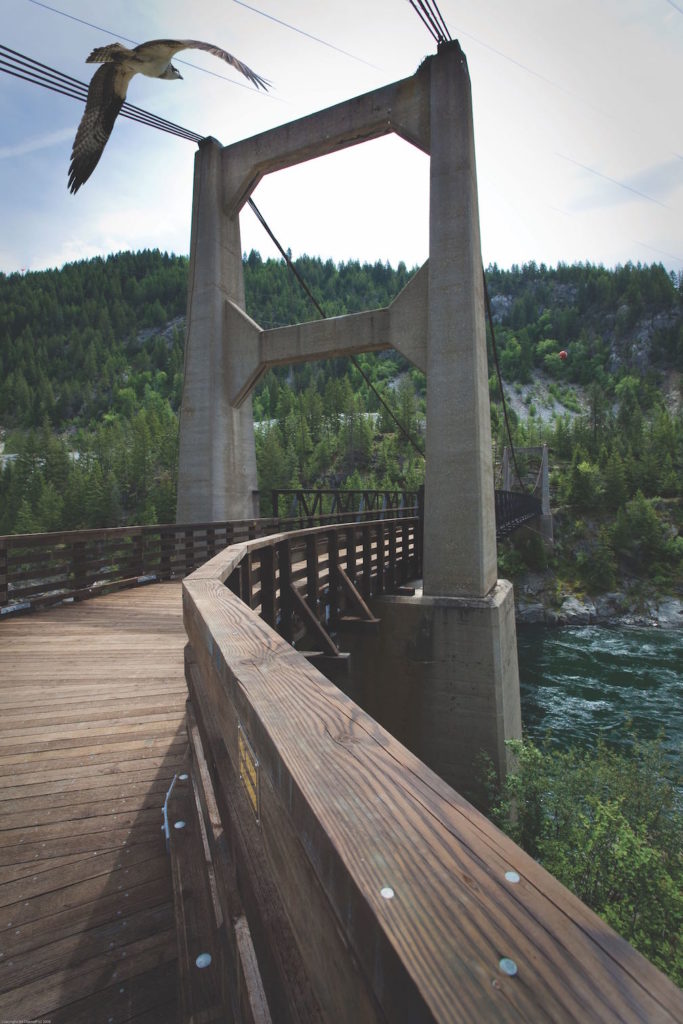Castlegar’s history dates back thousands of years to when the region was inhabited by the Lakes Salish First Nations people. The junction where the Kootenay River meets the Columbia, just south of where downtown Castlegar is now located, was an important trading place as well as a fishing spot for salmon.
Fur traders arrived in the late 1700s and when gold was discovered in 1855 near current day Trail, the region along the Columbia started to see more development. In 1865 the first steamer called the “Forty Nine” boated past what is now Castlegar. A few years later gold was discovered along Forty-Nine Creek towards Nelson thus cementing Castlegar’s important role as the midpoint of West Kootenay development.
In 1891 the first successful train journey occurred between Robson, near Castlegar, and Nelson ushering in an era of railroad development and commerce. That same year Edward Mahon moved to the region from his home in Castlegar, Ireland and became a successful land baron who eventually named the town site after his home across the Atlantic. He was also the one who gave the streets mineral names, such as Silver, Iron and Galena.

Aside from mining, Castlegar became an important hub for farming as the Doukhobors, who had escaped persecution in Russia at the turn of the century, bought up vast tracts of fertile soil from 1908 to 1913. Their leader, Peter V. Verigin, named the land near the current West Kootenay Regional Airport Dolina Ootischenia, meaning “Valley of Consolation” and he also named the community of Brilliant for its sparkling waters. It was around that time the Doukhobors also built the Brilliant Bridge, which spanned the Kootenay River and replaced the ferry service there.
In the middle of the 20th Century the regional airport, Selkirk College and the pulp mill were constructed as were many dams as part of the Columbia River Treaty, such as Hugh Keenleyside and Brilliant. Today, there are still important heritage sites in Castlegar related to the main events listed in the history above. Here are the five heritage venues not to be missed when you visit Castlegar.
5 Important Heritage Sites in Castlegar
The Doukhobor Discovery Centre
A religious group of Russian origin, the Doukhobors fled the Czarist government in the late 1800s and settled in Western Canada. The Doukhobor Discovery Museum is an amazing place to learn more about the culture that has so profoundly shaped what the city is today. You’ll find ten historic buildings on site and many displays that wonderfully recreate Doukhobor life in Castlegar in the early 20th Century.
- Doukhobor Discovery Centre
- 112 Heritage Way
- (250) 365-5327
- info@doukhobor-museum.org

The Railway Museum
The CPR Station Museum, or Railway Museum as it’s come to be called, is housed in a century-old station in downtown Castlegar and accurately portrays what it would have looked like during the railway boom in the early 1900s. Visitor’s will find a station agent’s residence on the upper floor and a perfectly-preserved caboose – a relic of a time when crew members lounged in the last car of the train in between shifts.
- CPR Station Museum
- 400 13th Ave.
- (250) 365-6440
- www.stationmuseum.ca

The Brilliant Bridge Regional Park
Declared a National Historic Site in 1995, the Brilliant Suspension Bridge was constructed 82 years earlier by members of the newly arrived Doukhobor population. It is located near the junction of Kootenay and Columbia Rivers and at the time of its construction connected the Doukhobor’s industrial hub of Brilliant (there was a very successful jam factory there) with village sites at Dolina Ootischenia. It consists of two paired concrete towers supporting steel cables from which the walkway hangs. In the ‘60s it eventually deemed redundant with the completion of the highway bridge in the ‘70s. Four decades later it was restored at the cost of one million dollars and today can be enjoyed by pedestrian traffic.
- Brilliant Bridge Regional Park
- 1839 Brilliant Road
- (250) 365-3386
- www.rdck.ca

Zuckerberg Island
Alexander Zuckerberg was a Russian-born artist, teacher and engineer who built a Chapel House in the style of Russian Orthodox country architecture on the island that came to bear his name. He moved to the region in the ‘30s and came to be revered by the local Doukhobor population. Visitors are encouraged to visit his home where you’ll still find examples of his artwork, as well as walk the grounds where you’ll learn about the Lakes Salish people who first fished and built winter pit houses here thousands of years ago.
- Zuckerberg Island
- 901 7th Ave
- (250) 365-6440
- www.stationmuseum.ca/zuckerberg

Verigin Memorial Park
As mentioned above, Peter V. Verigin was the leader of the local Doukhobors and was instrumental in the shaping of our community as we know it today. Sadly, he was assassinated in a still-unsolved CPR train explosion on October 29, 1924. Conspiracists believe the Canadian government was involved in the killing because Verigin’s influence and beliefs regarding communal existence threatened the more authoritarian rule of the day. Today his tomb can be found at the park bearing his name as well as manicured lawns and flower gardens. It is also a popular site in the winter months for children to toboggan at.
- Verigin Memorial Park
- 1850 Terrace Rd
- (250) 442-8252
- www.doukhobor.org

